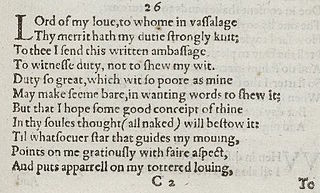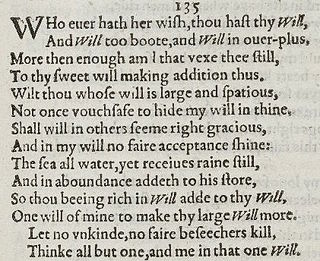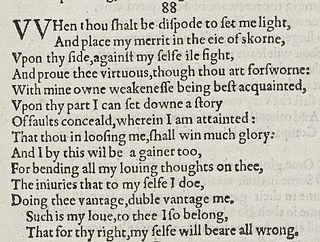| Sonnet 133 | |||||||
|---|---|---|---|---|---|---|---|
 Sonnet 133 in the 1609 Quarto | |||||||
| | |||||||
| |||||||
Sonnet 133 is a poem in sonnet form written by William Shakespeare, first published in 1609 in Shakespeare's sonnets .
| Sonnet 133 | |||||||
|---|---|---|---|---|---|---|---|
 Sonnet 133 in the 1609 Quarto | |||||||
| | |||||||
| |||||||
Sonnet 133 is a poem in sonnet form written by William Shakespeare, first published in 1609 in Shakespeare's sonnets .
Critics generally agree that Sonnet 133 addresses the complex relationship between the speaker and an unidentified woman. Josephine Roberts interprets the sonnet in that the poet expresses a "fractured sense of self" [2] as a result of his toxic relationship with the Dark Lady. Her interpretation of the relationship as "toxic" is evident in the emotional plea that resounds throughout the sonnet. The sonnets prior to this address a young man referred to as a close friend of the speaker who is thus addressed as well in sonnet 133. According to critic A. L. Rowse, this sonnet gives the speaker's view of both his relation of the young man as his friend and the mistress. [3] Rowse's interpretation is supported by how the sonnet clearly describes the pain the unknown woman has inflicted upon both the young man and the speaker, "For that deep wound it gives my friend and me!"
Sonnet 133 is an English or Shakespearean sonnet. The English sonnet has three quatrains, followed by a final rhyming couplet. It follows the typical rhyme scheme of the form ABAB CDCD EFEF GG and is composed in iambic pentameter, a type of poetic metre based on five pairs of metrically weak/strong syllabic positions. The 1st line exemplifies a regular iambic pentameter:
× / × / × / × / × / Beshrew that heart that makes my heart to groan (133.1)
Line 5 exhibits two common metrical variations: an initial reversal, and a final extrametrical syllable or feminine ending:
/ × × / × /× / × /(×) Me from myself thy cruel eye hath taken, (133.5)
Line 7 also (necessarily, given the rhyme scheme) has a feminine ending. An initial reversal occurs in line 9. A mid-line reversal occurs in line 8 — "thus to" — "threefold", while typically stressed on the first syllable, does not constitute a reversal because it is a double-stressed word, and in context the stress can shift to the second syllable.
Line 2 begins with the rightward movement of the first ictus (resulting in a four-position figure, × × / /, sometimes referred to as a minor ionic):
× × / / × / × / × / For that deep wound it gives my friend and me! (133.2)
Lines 4 and 6 also contain minor ionics, and line 9 potentially does.
The meter demands that line 13's "being" function as one syllable. [4]
Helen Vendler describes the stages of the sonnet in that it begins with a listing of the conflict in Quatrain One then proceeds in Quatrain Two to show the effects and complications. Specifically the problem of this sonnet is the torture the dark lady has caused the two men to suffer. The effects and complications of this situation are pronounced throughout Quatrain Two indicating that the speaker may recover but the young man is reduced to her slave under her influence. In Quatrain Three, Vendler says that the "intolerable complication of effect" forces a request for relief and intelligibility which end in a helpless giving up reflected in the couplet. [5]
Analyzing specific words within the sonnets gives further evidence of the Quatrain transition. It begins with the first line in which the speaker declares that he is separate from her by saying "that heart (of hers) makes my heart groan". [6] Although he declares himself separate from her, her cruel eye has taken the speaker from himself and not only this, but she has taken his "next self", which refers to his friend as addressed earlier in the sonnets. Stephen Booth further explains this point arguing that the implied logic of lines 3 and 4 suggest that if the Dark Lady possesses the friend then she should release the speaker. He also addressed the cruel eye of the speaker saying that Sonnet 133 continues the theme of hearts and eyes from Sonnet 132, and Booth notes the shift from the friend's image of "mourning eyes" to the "cruel eye"(line 5) of the mistress. Booth continues his analysis with lines 10-11 of which he suggests that they, "add one more element to the verbal complexities and confusions by which the complex and confused three-way love affair is both reported and imitated". [7] Helen Vendler emphasizes his point by explaining that now the friend is enslaved by her as well as the speaker as evidenced in the final line of the couplet, "Perforce am thine, and all that is mine" (Line 14). She says that because he belongs to her he is thus forsaken. [8] Both Booth and Vendler suggest that everything that belongs to the speaker, including his friend's heart, bears the surrender to the dark lady.
Because sonnet 133 is the first to directly refer to the "friend", [9] there is some controversy concerning the subject of that word. Joel Fineman argues that in this sonnet, the poet feels trapped by the Dark Lady, who represents the constraints of a heteronormative society. She has taken the "friend", or the poet's homosexual side, from him, preventing the poet from living in his self-created utopia of homosexuality with the Young Man. [10] Unlike the young man sequence, in which the poet "defines his own identity [. . .] as poet and lover", in the Dark Lady sequence, particularly sonnet 133, "the poet-lover of the [D]ark [L]ady will discover both himself and his poetry in the loss produced by the fracture of [his ideal identification as homosexual]". [11] Other critics argue that the Dark Lady has enslaved a literal friend, the Young Man, [12] creating a love triangle between the poet, the Young Man and the Dark Lady. [13] "The suggestion is that the friend had gone to woo the lady for the poet and, according to friendship convention [. . .] the lady fell in love with the messenger". [14] Leishman also calls her a "bad angel who has tempted away that good angel his friend". [15]
Critics note that throughout Sonnet 133, Shakespeare uses slave imagery as a metaphor for the relationship between the speaker and the Dark Lady. The theme of subservience is quite prevalent in representations of traditional courtly love. The relationship is expressed throughout the sonnet with words like "torture", "slave", "torment", "prison", and "jail". Critic Stephen Booth holds that the metaphor within this sonnet is "so complete, so urgent, so detailed… that the lovers and their situation, and their behavior becomes grotesque". [16] Booth explains that the slave imagery is a commonly used metaphor, the wording of the speaker's metaphors creates a witty and unconventional depiction of his relationship with the unknown woman. Through phrases such as "pent in thee" found in line 13, the reader is exposed to the image of the speaker imprisoned in the Dark Lady. Furthermore, in line 4 ("But slave to slavery my sweet'st friend must be?") we see the speaker playing on the hyperbole "by which lovers swore themselves their ladies' willing slave". [17] Essentially, Booth points out that although the speaker conforms with the traditional "slave" metaphor, he appears to almost resent his place in a relationship that is ultimately debilitating.
Scholarly critic Gertrude Garrigues argues that Shakespeare's use of slave imagery is simply symbolic of man as a "slave of the senses". [18] Garrigues counters Booth's argument in her assertion that the speaker is simply a slave to his own feelings and not a slave to the dark lady. Despite the speaker's great affliction over his relationship with the dark lady, he has willingly subjected himself to such unbearable torment. In relationship to this argument, it can be argued that the "friend" within Shakespeare's Sonnet 133 is in fact representative of the speaker's inner self. This strengthens Garrigues' argument, most notably in the line 4 where the speaker states, "But slavery to slavery my sweet'st friend must be?" When read in light of Garrigues' assertions, the reader can see that the speaker is referring to being enslaved by himself, or his senses.

Sonnet 1 is one of 154 sonnets written by the English playwright and poet William Shakespeare. It is a procreation sonnet within the Fair Youth sequence.

Sonnet 15 is one of 154 sonnets written by the English playwright and poet William Shakespeare. It forms a diptych with Sonnet 16, as Sonnet 16 starts with "But...", and is thus fully part of the procreation sonnets, even though it does not contain an encouragement to procreate. The sonnet is within the Fair Youth sequence.

Sonnet 26 is one of 154 sonnets written by the English playwright and poet William Shakespeare, and is a part of the Fair Youth sequence.

Sonnet 28 is one of 154 sonnets published by the English playwright and poet William Shakespeare in 1609. It is a part of what is considered the Fair Youth group, and part of another group that focuses on the solitary poet reflecting on his friend. There is a theme of night and sleeplessness, which is a traditional motif that also occurs in Petrarchan sonnets.

Shakespeare's Sonnet 33 is one of 154 sonnets written by the English playwright and poet William Shakespeare. It is a member of the Fair Youth sequence, in which the poet expresses his love towards a young man. This sonnet is the first of what are sometimes called the estrangement sonnets, numbers 33–36: poems concerned with the speaker's response to an unspecified "sensual fault" mentioned in (35) committed by his beloved.

William Shakespeare's Sonnet 35 is part of the Fair Youth sequence, commonly agreed to be addressed to a young man; more narrowly, it is part of a sequence running from 33 to 42, in which the speaker considers a sin committed against him by the young man, which the speaker struggles to forgive.

Sonnet 42 is one of 154 sonnets written by the English playwright and poet William Shakespeare. It is a part of the Fair Youth section of the sonnets addressed to an unnamed young man.

Sonnet 138 is one of the most famous of William Shakespeare's sonnets. Making use of frequent puns, it shows an understanding of the nature of truth and flattery in romantic relationships. The poem has also been argued to be biographical: many scholars have suggested Shakespeare used the poem to discuss his frustrating relationship with the Dark Lady, a frequent subject of many of the sonnets. The poem emphasizes the effects of age and the associated deterioration of beauty, and its effect on a sexual or romantic relationship.

Sonnet 56 is one of 154 sonnets written by the English playwright and poet William Shakespeare. It is a member of the Fair Youth sequence, in which the poet expresses his love towards a young man. The exact date of its composition is unknown, it is thought that the Fair Youth sequence was written in the first half of the 1590s and was published with the rest of the sonnets in the 1609 Quarto.

Sonnet 64 is one of 154 sonnets written by the English playwright and poet William Shakespeare. It is a member of the Fair Youth sequence, in which the poet expresses his love towards a young man.

Sonnet 71 is one of 154 sonnets written by the English playwright and poet William Shakespeare. It's a member of the Fair Youth sequence, in which the poet expresses his love towards a young man. It focuses on the speaker's aging and impending death in relation to his young lover.

In Shakespeare's Sonnet 135, the speaker appeals to his mistress after having been rejected by her.

Sonnet 134 is one of 154 sonnets written by the English poet and playwright William Shakespeare. In it, the speaker confronts the Dark Lady after learning that she has seduced the Fair Youth.

Sonnet 144 was published in the Passionate Pilgrim (1599). Shortly before this, Francis Meres referred to Shakespeare's Sonnets in his handbook of Elizabethan poetry, Palladis Tamia, or Wit's Treasurie, published in 1598, which was frequently talked about in the literary centers of London taverns. Shakespeare's sonnets are mostly addressed to a young man, but the chief subject of Sonnet 127 through Sonnet 152 is the "dark lady". Several sonnets portray a conflicted relationship between the speaker, the "dark lady" and the young man. Sonnet 144 is one of the most prominent sonnets to address this conflict.

Sonnet 136 is one of 154 sonnets written by the English playwright and poet William Shakespeare.

Sonnet 127 of Shakespeare's sonnets (1609) is the first of the Dark Lady sequence, called so because the poems make it clear that the speaker's mistress has black hair and eyes and dark skin. In this poem the speaker finds himself attracted to a woman who is not beautiful in the conventional sense, and explains it by declaring that because of cosmetics one can no longer discern between true and false beauties, so that the true beauties have been denigrated and out of favour.

Sonnet 78 is one of 154 sonnets published by the English playwright and poet William Shakespeare in 1609. It is one of the Fair Youth sequence, and the first of the mini-sequence known as the Rival Poet sonnets, thought to be composed some time from 1598 to 1600.

Sonnet 88 is one of 154 sonnets published in 1609 by the English playwright and poet William Shakespeare. It's one of the Fair Youth sequence.

Sonnet 84 is one of 154 sonnets published by the English playwright and poet William Shakespeare in 1609. It's part of the Fair Youth sequence, and the seventh sonnet of the Rival Poet group.

Sonnet 87 is one of 154 sonnets published by the English playwright and poet William Shakespeare in 1609. It is part of the Fair Youth sequence, and sometimes included as the last sonnet in the Rival Poet group.